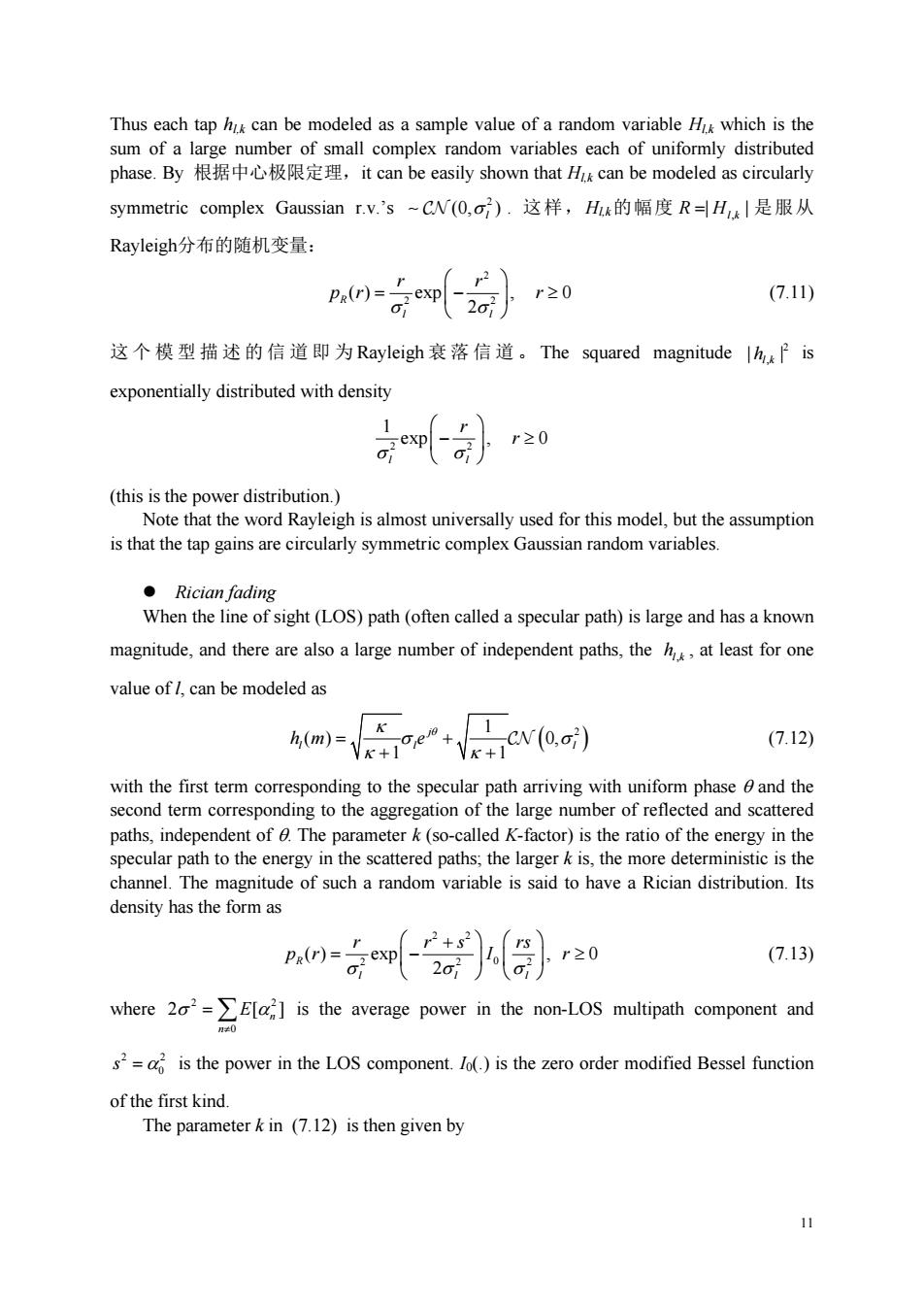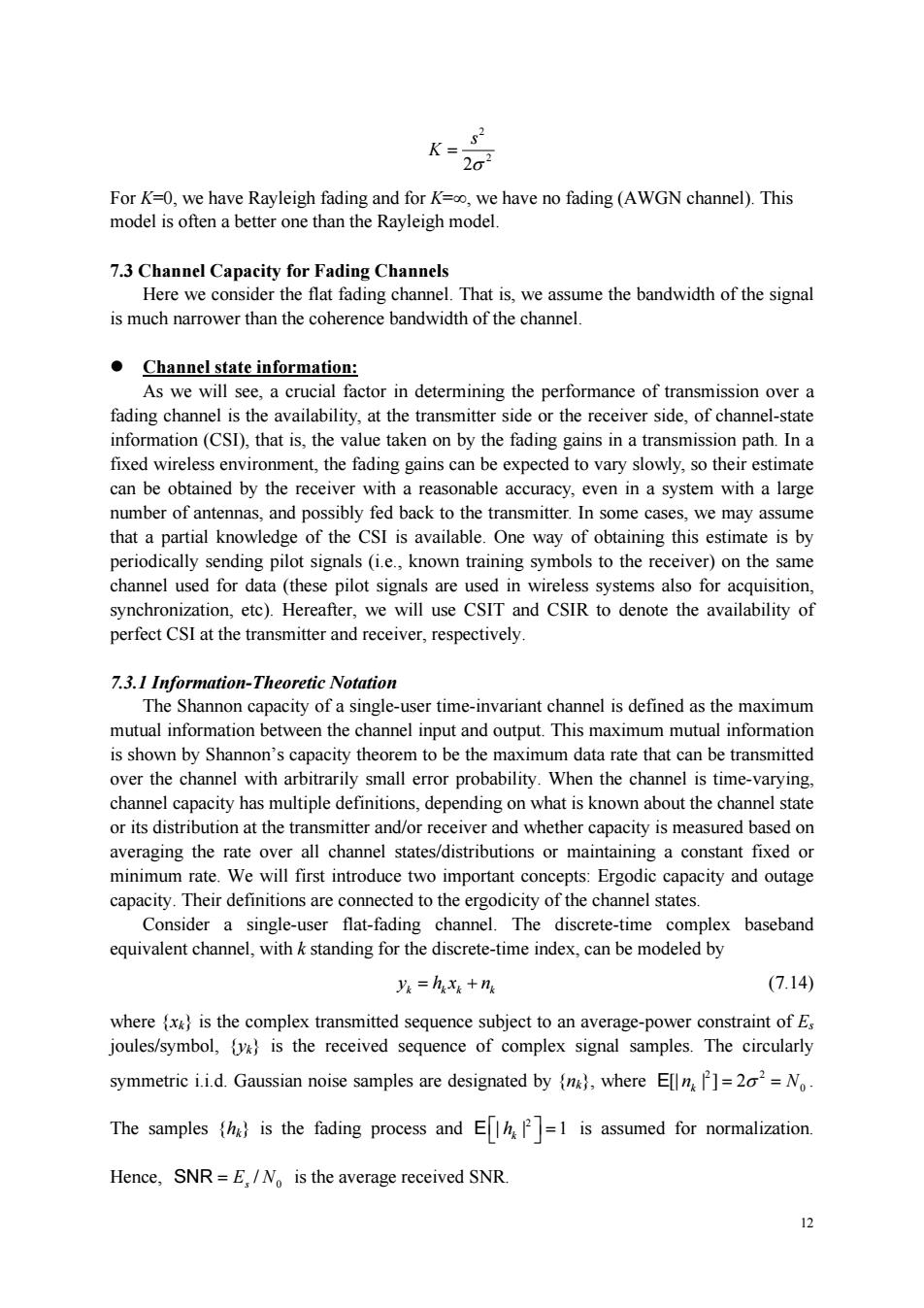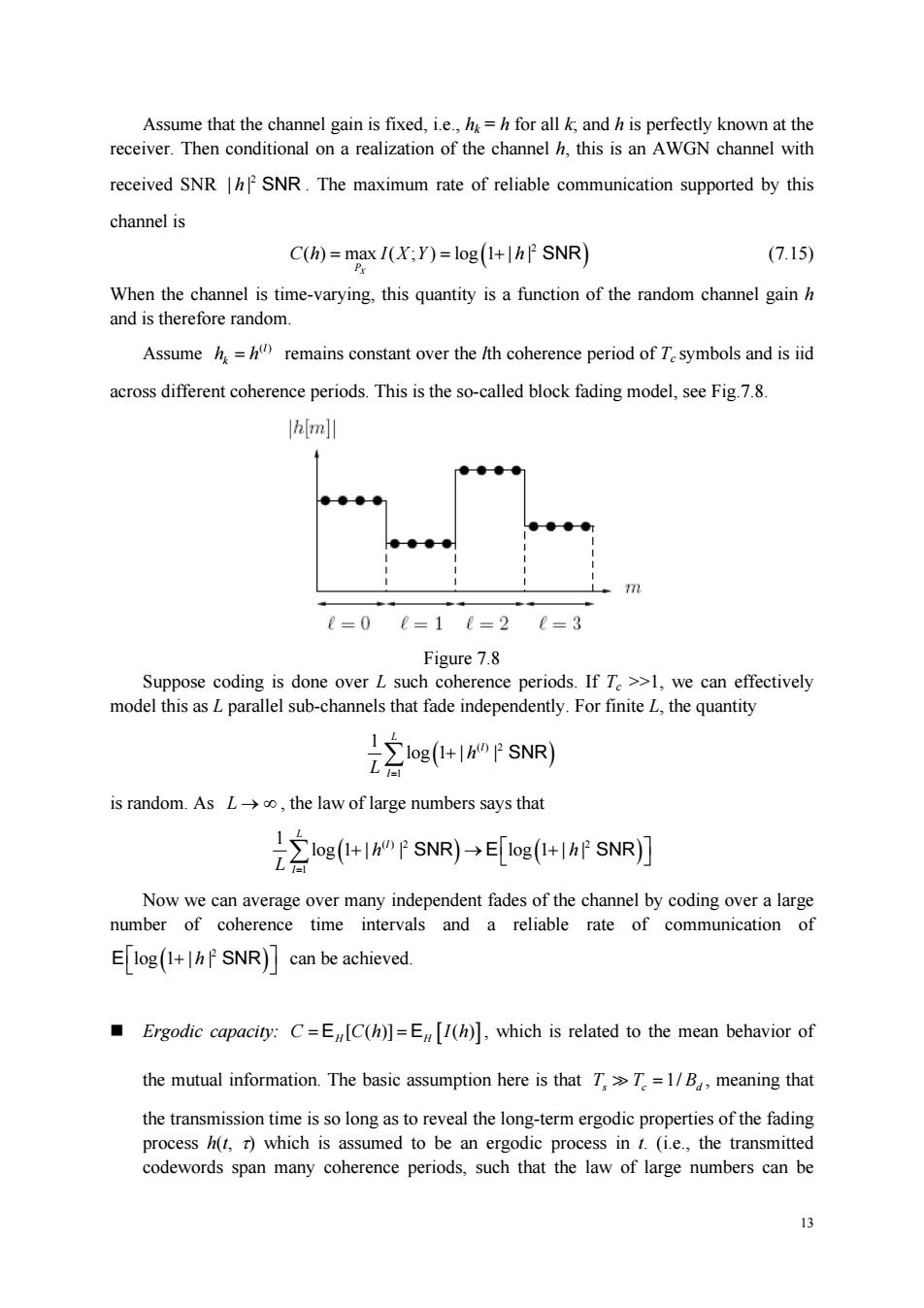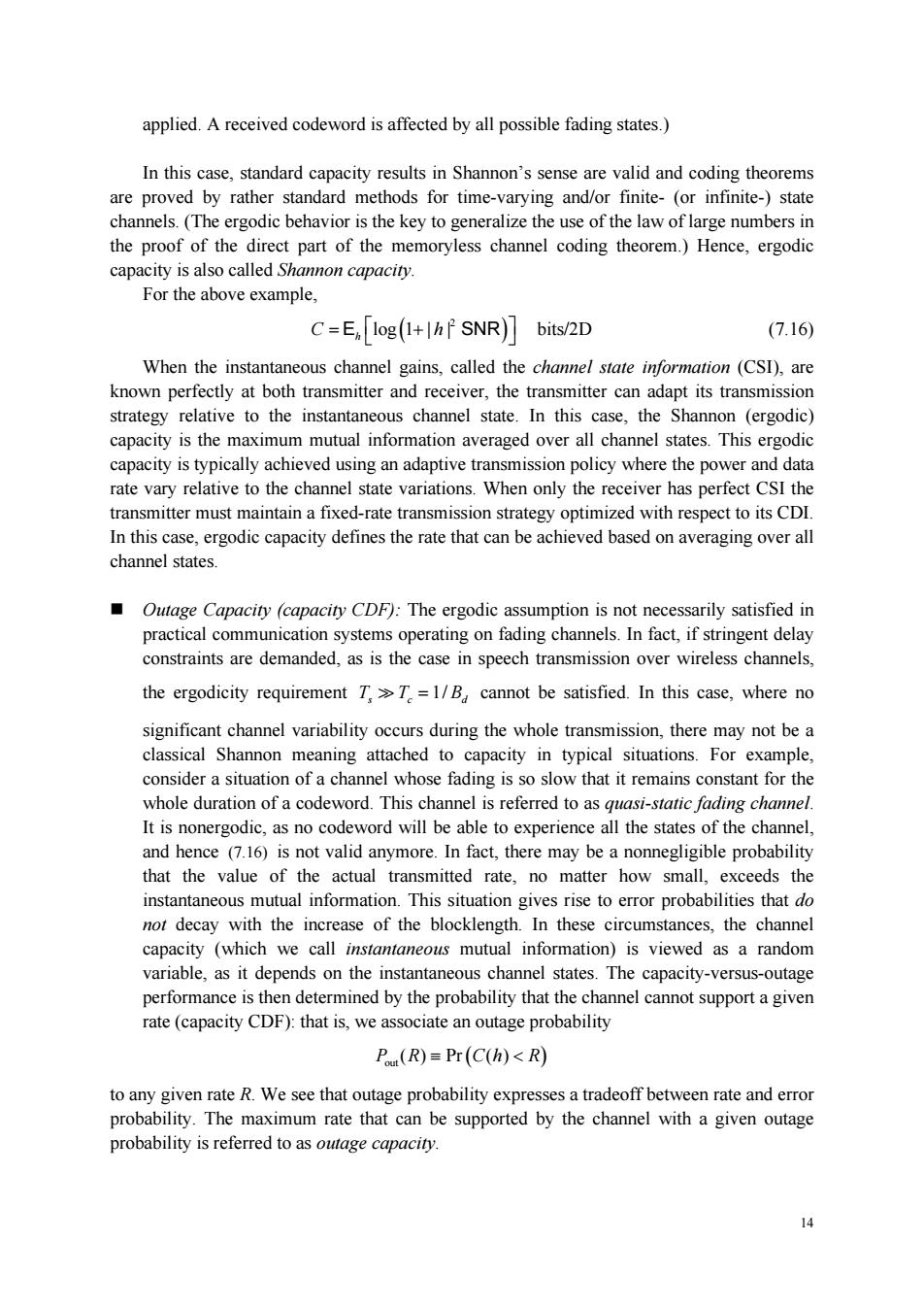
Thus each tap h can be modeled as a sample value of a random variable H which is the sum of a large number of small complex random variables each of uniformly distributed phase.By根据中心极限定理,be be modeled symmetric complex Gaussian.rv.'s-CN(O,o).这样,Hx的幅度R=Ha|是服从 Rayleigh分布的随机变量: Px(r)= r2】 r20 (7.11) 这个模型描述的信道即为Rayleigh衰落信道。The squared magnitude is exponentially distributed with density exp r20 (this is the power distribution.) Note that the word Rayleigh is almost universally used for this model,but the assumption is that the tap gains are circularly symmetric complex Gaussian random variables. ●Rician fadin When the line of sight(LOS)path (often called a specular path)is large and has a known magnitude,and there are also a large number of independent paths,theat least for one value ofl,can be modeled as 1 Cv(0) (7.12) with the first term corresponding to the specular path arriving with uniform phase 6 and the second term corresponding to the aggregation of the large number of reflected and scattered paths,independent of The parameter k(so-called K-factor)is the ratio of the energy in the ehin thd ths the arger the mor eteminsi is the The of such a random variable is said to have a Rician distribution.Its density has the form as (7.13) where is the average power in the non-LOS mulipath component and s2=is the power in the LOS component./o()is the zero order modified Bessel function of the first kind. The parameter k in (7.12)is then given by 11
11 Thus each tap hl,k can be modeled as a sample value of a random variable Hl,k which is the sum of a large number of small complex random variables each of uniformly distributed phase. By 根据中心极限定理,it can be easily shown that Hl,k can be modeled as circularly symmetric complex Gaussian r.v.’s 2 (0, ) l . 这样,Hl,k的幅度 , | | R H l k 是服从 Rayleigh分布的随机变量: 2 2 2 ( ) exp , 0 2 R l l r r pr r (7.11) 这个模型描述的信道即为 Rayleigh 衰落信道。 The squared magnitude 2 , | | l k h is exponentially distributed with density 2 2 1 exp , 0 l l r r (this is the power distribution.) Note that the word Rayleigh is almost universally used for this model, but the assumption is that the tap gains are circularly symmetric complex Gaussian random variables. Rician fading When the line of sight (LOS) path (often called a specular path) is large and has a known magnitude, and there are also a large number of independent paths, the l k, h , at least for one value of l, can be modeled as 1 2 ( ) 0, 1 1 j ll l hm e (7.12) with the first term corresponding to the specular path arriving with uniform phase and the second term corresponding to the aggregation of the large number of reflected and scattered paths, independent of . The parameter k (so-called K-factor) is the ratio of the energy in the specular path to the energy in the scattered paths; the larger k is, the more deterministic is the channel. The magnitude of such a random variable is said to have a Rician distribution. Its density has the form as 2 2 2 22 0 ( ) exp , 0 2 R l ll r r s rs pr I r (7.13) where 2 2 0 2 [] n n E is the average power in the non-LOS multipath component and 2 2 0 s is the power in the LOS component. I0(.) is the zero order modified Bessel function of the first kind. The parameter k in (7.12) is then given by

For K=0,we have Rayleigh fading and for K=o,we have no fading(AWGN channel).This model is often a better one than the Rayleigh model. 7.3 Channel Capacity for Fading Channels Here we consi er the flat fading channe .That is,we assume the bandwidth of the signal is much narrower than the coherence bandwidth of the channel Channel state information: As we will see,a crucial factor in determining the performance of transmission over a fading channel is the availability,at the transmitte e or the receiver side,of channel-s information(CSD).that is,the value taken on by the fading gains in a transmission path.In a fixed wireless environment,the fading gains can be expected to vary slowly,so their estimate can be obtained by the receiver with a reasonable accuracy,even in a system with a large number of antennas,and possibly fed back to the transmitter.In some cases,we may assume that a partial k f the CSI is available.One wa of obtaining this estim is by periodically sending pilot signals (i.e.,known training symbols to the receiver)on the same channel used for data (these pilot signals are used in wireless systems also for acquisition, synchronization,etc).Hereafter,we will use CSIT and CSIR to denote the availability of perfect CSIat the transmitter and receiver,respectively. retic Notati y ofertiminvn hnte mutual information between the channel input and output.This maximum mutual information is shown by Shannon's capacity theorem to be the maximum data rate that can be transmitted over the channel with arbitrarily small error probability.When the channel is time-varying, chanr city has multipledefinitions dep nding on what is kn own about the char ne l state or its distribution at the transmitter and/or receiver and whether capacity is measured based on averaging the rate over all channel states/distributions or maintaining a constant fixed or minimum rate.We will first introduce two important concepts:Ergodic capacity and outage capacity.Their definitions are connected to the ergodicity of the channel states. Consider a single-user flat-fading channel.The discrete-time complex baseband equivalent channel,withk standing for the discrete-time index,can be modeled by y:=hx+ng (7.14) wherex is the complex transmitted sequence subject to an average-power constraint of E joules/symbol,is the received sequence of complex signal samples.The circularly symmetric i.i.d.Gaussian noise samples are designated by where El]=N The samples is the fading process and E=1 is assumed for normalization. Hence,SNR=E,/N is the average received SNR
12 2 2 2 s K For K=0, we have Rayleigh fading and for K=, we have no fading (AWGN channel). This model is often a better one than the Rayleigh model. 7.3 Channel Capacity for Fading Channels Here we consider the flat fading channel. That is, we assume the bandwidth of the signal is much narrower than the coherence bandwidth of the channel. Channel state information: As we will see, a crucial factor in determining the performance of transmission over a fading channel is the availability, at the transmitter side or the receiver side, of channel-state information (CSI), that is, the value taken on by the fading gains in a transmission path. In a fixed wireless environment, the fading gains can be expected to vary slowly, so their estimate can be obtained by the receiver with a reasonable accuracy, even in a system with a large number of antennas, and possibly fed back to the transmitter. In some cases, we may assume that a partial knowledge of the CSI is available. One way of obtaining this estimate is by periodically sending pilot signals (i.e., known training symbols to the receiver) on the same channel used for data (these pilot signals are used in wireless systems also for acquisition, synchronization, etc). Hereafter, we will use CSIT and CSIR to denote the availability of perfect CSI at the transmitter and receiver, respectively. 7.3.1 Information-Theoretic Notation The Shannon capacity of a single-user time-invariant channel is defined as the maximum mutual information between the channel input and output. This maximum mutual information is shown by Shannon’s capacity theorem to be the maximum data rate that can be transmitted over the channel with arbitrarily small error probability. When the channel is time-varying, channel capacity has multiple definitions, depending on what is known about the channel state or its distribution at the transmitter and/or receiver and whether capacity is measured based on averaging the rate over all channel states/distributions or maintaining a constant fixed or minimum rate. We will first introduce two important concepts: Ergodic capacity and outage capacity. Their definitions are connected to the ergodicity of the channel states. Consider a single-user flat-fading channel. The discrete-time complex baseband equivalent channel, with k standing for the discrete-time index, can be modeled by k kk k y hx n (7.14) where {xk} is the complex transmitted sequence subject to an average-power constraint of Es joules/symbol, {yk} is the received sequence of complex signal samples. The circularly symmetric i.i.d. Gaussian noise samples are designated by {nk}, where 2 2 0 [| | ] 2 k E n N . The samples {hk} is the fading process and 2 || 1 k h E is assumed for normalization. Hence, 0 / SNR E N s is the average received SNR

Assume that the channel gain is fixed,i.e.,h=h for all k,and h is perfectly known at the receiver.Then conditional on a realization of the channel h,this is an AWGN channel with received SNRSNR.The maximum rate of reliable communication supported by this channel is C(h)=max /(X;Y)=log(1+h SNR) (7.15) When the channel is time-varying.this quantity is a function of the random channel gain and is therefore random. Assumehremains constant over the /th coherence period of Tsymbols and is iid across different coherence periods.This is the so-called block fading model,see Fig.7.8. .m 0=0e=10=2e=3 Figure 78 Suppose coding is done over L such eriods.If T,we can effectively model this asLparallel sub-channels that fade independently.For finite the quantity og(SNR) is random.AsL,the law of large numbers says that ee SN)→E[e1 IF NR)町 Now we can average over many independent fades of the channel by coding over a large number of coherence time intervals and a reliable rate of communication of E log(1+h SNR)can be achieved. Ergodic capacity:C=E[C(h)]=E[(h)].which is related to the mean behavior of the mutual information.The basic assumption here is that T,T=1/B,meaning that the transmission time is so long as to reveal the long-term ergodic properties of the fading process h(t,r)which is assumed to be an ergodic process in t.(i.e.,the transmitted codewords span many coherence periods,such that the law of large numbers can be 13
13 Assume that the channel gain is fixed, i.e., hk = h for all k; and h is perfectly known at the receiver. Then conditional on a realization of the channel h, this is an AWGN channel with received SNR 2 | | h SNR . The maximum rate of reliable communication supported by this channel is 2 ( ) max ( ; ) log 1 | | PX Ch I XY h SNR (7.15) When the channel is time-varying, this quantity is a function of the random channel gain h and is therefore random. Assume ( )l k h h remains constant over the lth coherence period of Tc symbols and is iid across different coherence periods. This is the so-called block fading model, see Fig.7.8. Figure 7.8 Suppose coding is done over L such coherence periods. If Tc >>1, we can effectively model this as L parallel sub-channels that fade independently. For finite L, the quantity () 2 1 1 log 1 | | L l l h L SNR is random. As L , the law of large numbers says that () 2 2 1 1 log 1 | | log 1 | | L l l h h L SNR E SNR Now we can average over many independent fades of the channel by coding over a large number of coherence time intervals and a reliable rate of communication of 2 log 1 | | h E SNR can be achieved. Ergodic capacity: C Ch Ih E E H H [ ( )] ( ) , which is related to the mean behavior of the mutual information. The basic assumption here is that 1/ TT B s c d , meaning that the transmission time is so long as to reveal the long-term ergodic properties of the fading process h(t, ) which is assumed to be an ergodic process in t. (i.e., the transmitted codewords span many coherence periods, such that the law of large numbers can be

applied.A received codeword is affected by all possible fading states.) In this case,standard capacity results in Shannon's sense are valid and coding theorems are proved by rather standard methods for time-varying and/or finite-(or infinite-)state channels.(The ergodic behavior is the key to generalize the use of the law of large numbers in the proof of the direct part of the memoryless channel coding theorem.)Hence,ergodic cap ity is also called Shannon capacity. For the above example. C=E,log(1+SNR)bits/2D (7.16) When the instantaneous channel gains,called the channel state information (CSI),are strategy relative to the instant nnel state In this ase,the (ergodic capacity is the maximum mutual information averaged over all channel states.This ergodic capacity is typically achieved using an adaptive transmission policy where the power and data rate vary relative to the channel state variations.When only the receiver has perfect CSI the transmitter must maintain a fixed-rate transmission strategy optimized with respect to its CDI. n this ergodic capacity defines the rate that can be chieved based on averaging over all channel states Outage Capacity (capacity CDF):The ergodic assumption is not necessarily satisfied in practical onsysmperaingn fading chane In factndelay constraints are demanded,as is the case in speech transmission over wireless channels, the ergodicity requirement T=1/B cannot be satisfied.In this case,where no significant channel variability occurs during the whole transmission,there may not be a classical Shannon meaning attached to capacity in typical situations.For example, consider a situation of a channel whose fading is so slow that it remains constant for the whole duration of a codev ord This char nnel s referred to as ng cha It is nonergodic,as no codeword will be able to experience all the state es of the channel and hence (7.16)is not valid anymore.In fact,there may be a nonnegligible probability that the value of the actual transmitted rate,no matter how small,exceeds the instantaneous mutual information.This situation gives rise to error probabilities that do not decay with the increase of the blocklength.In these circumstances,the channel capacity (whic we call al information)is viewed as a random variable,as it depends on the instantaneous channel states.The capacity-versus-outage performance is then determined by the probability that the channel cannot support a given rate (capacity CDF):that is,we associate an outage probability P(R)=Pr(C(h)<R) to any given rate R.We see that outage probability expresses a tradeoff between rate and error probability.The maximum rate that can be supported by the channel with a given outage probability is referred to as outage capacity
14 applied. A received codeword is affected by all possible fading states.) In this case, standard capacity results in Shannon’s sense are valid and coding theorems are proved by rather standard methods for time-varying and/or finite- (or infinite-) state channels. (The ergodic behavior is the key to generalize the use of the law of large numbers in the proof of the direct part of the memoryless channel coding theorem.) Hence, ergodic capacity is also called Shannon capacity. For the above example, 2 log 1 | | C h h E SNR bits/2D (7.16) When the instantaneous channel gains, called the channel state information (CSI), are known perfectly at both transmitter and receiver, the transmitter can adapt its transmission strategy relative to the instantaneous channel state. In this case, the Shannon (ergodic) capacity is the maximum mutual information averaged over all channel states. This ergodic capacity is typically achieved using an adaptive transmission policy where the power and data rate vary relative to the channel state variations. When only the receiver has perfect CSI the transmitter must maintain a fixed-rate transmission strategy optimized with respect to its CDI. In this case, ergodic capacity defines the rate that can be achieved based on averaging over all channel states. Outage Capacity (capacity CDF): The ergodic assumption is not necessarily satisfied in practical communication systems operating on fading channels. In fact, if stringent delay constraints are demanded, as is the case in speech transmission over wireless channels, the ergodicity requirement 1/ TT B s c d cannot be satisfied. In this case, where no significant channel variability occurs during the whole transmission, there may not be a classical Shannon meaning attached to capacity in typical situations. For example, consider a situation of a channel whose fading is so slow that it remains constant for the whole duration of a codeword. This channel is referred to as quasi-static fading channel. It is nonergodic, as no codeword will be able to experience all the states of the channel, and hence (7.16) is not valid anymore. In fact, there may be a nonnegligible probability that the value of the actual transmitted rate, no matter how small, exceeds the instantaneous mutual information. This situation gives rise to error probabilities that do not decay with the increase of the blocklength. In these circumstances, the channel capacity (which we call instantaneous mutual information) is viewed as a random variable, as it depends on the instantaneous channel states. The capacity-versus-outage performance is then determined by the probability that the channel cannot support a given rate (capacity CDF): that is, we associate an outage probability out P R Ch R ( ) Pr ( ) to any given rate R. We see that outage probability expresses a tradeoff between rate and error probability. The maximum rate that can be supported by the channel with a given outage probability is referred to as outage capacity